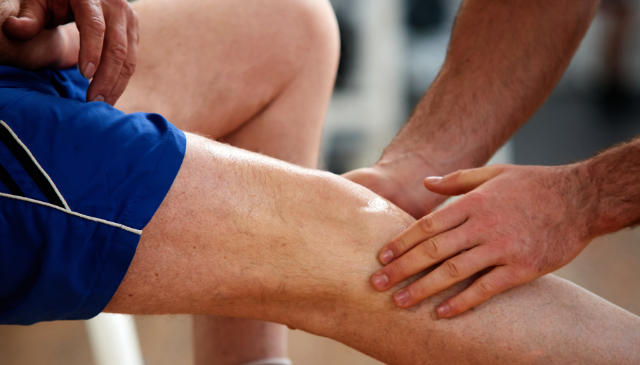News
Runners Can Overcome a Common Knee Condition With Physical Therapy

Iliotibial band syndrome, or ITBS, has earned a reputation as one of the most persistent obstacles encountered by runners. This common overuse injury, which is responsible for up to 22% of all running–related injuries in the lower extremities, causes a characteristic sharp pain along the outside of the knee that gets worse with activity. As a result, runners and other athletes are often stopped in their tracks and unable to continue until symptoms subside.
But there's good news: with a well–designed physical therapy program, ITBS can be both treated and prevented in those who have an elevated risk. Recent research provides valuable insights into the most effective approaches for addressing ITBS, many of which are frequently used in physical therapy. With that in mind, let's take a look at these findings and explore how physical therapy can help you overcome ITBS and get back to doing what you love.
Taking a closer look at iliotibial band syndrome
The iliotibial (IT) band is a thick band of fibrous tissue that runs along the outside of the thigh, from the hip to the knee. It plays a crucial role in stabilizing the knee during running and other activities. ITBS occurs when this band becomes irritated or inflamed, which is typically due to repetitive friction as it rubs against a bony prominence on the outside of the knee called the lateral femoral epicondyle.
Several factors can contribute to ITBS, including:
- Repetitive movements: activities like running or cycling can put excessive strain on the IT band
- Weak hip and gluteal muscles: poor strength in these areas can alter movement patterns, increasing stress on the IT band
- Improper footwear: worn–out or unsupportive shoes can contribute to poor knee mechanics
- Training errors: suddenly increasing mileage or intensity can overload the IT band
- Tightness in and around the IT band: limited flexibility can lead to excessive friction and irritation
The most common symptom of ITBS is pain on the outside of the knee, which may worsen with activity or radiate up the thigh or down the lower leg. Other symptoms that may occur include tenderness over the lateral femoral epicondyle and a popping or snapping sensation as the IT band moves over the bone.
Many interventions commonly used in physical therapy are best for ITBS
To determine the most effective conservative treatments for ITBS in runners, researchers conducted a systematic review that analyzed data from multiple studies. The goal of the review was to identify the most effective interventions for ITBS and provide evidence–based recommendations based on these interventions for physical therapists and other healthcare professionals to follow. Researchers performed a search of several databases and analyzed various treatments–including stretching, strengthening exercises, manual therapy, and biomechanical adjustments–to determine what works best for recovery.
Several key findings emerged from this review, including the following:
- Strengthening exercises for the hip and gluteal muscles were among the most effective treatments; weakness in these muscles contributes to poor running mechanics, which can aggravate the IT band
- Manual therapy, which encompasses a variety of hands–on therapy techniques, provided temporary relief but were most effective when combined with strengthening exercises
- Stretching the IT band alone was not found to be particularly effective in long–term recovery, but improving flexibility in the surrounding muscles (like the hip flexors and quadriceps) helped reduce strain on the IT band
- Adjusting movement mechanics, such as running gait retraining, played an important role in preventing recurrence
These findings show that physical therapy is well positioned to offer benefits for patients with ITBS, since all of these beneficial interventions are commonly used in treatment. Each management plan is personalized for the patient based on their needs, abilities, and goals, but a typical program for ITBS will likely feature the following:
- Targeted strength training: strengthening the hip abductors, glutes, and core muscles to improve stability and reduce IT band strain
- Manual therapy: manipulation and mobilization for the structures in and around the knee to alleviate tightness and improve mobility
- Movement assessments and biomechanics training: addressing gait abnormalities and improper movement patterns to prevent re–injury
- Flexibility and mobility work: stretching and foam rolling techniques to improve mobility in surrounding muscles and reduce friction
- Progressive return to activity: a structured plan to safely resume running, cycling, or other activities without aggravating symptoms
Start taking control of your knee pain today!
If you're experiencing pain on the outside of your knee, don't let ITBS keep you on the sidelines. Contact our clinic today to schedule a consultation with one of our experienced physical therapists. We'll conduct a thorough evaluation, identify the underlying causes of your pain, and develop a personalized treatment plan to help you get back on track. Or to read more on the featured study, visit the journal's website here.
Disclaimer:
The information in the articles, posts, and newsfeed is intended for informational and educational purposes only and in no way should be taken to be the provision or practice of physical therapy, medical, or professional healthcare advice or services. The information should not be considered complete or exhaustive and should not be used for diagnostic or treatment purposes without first consulting with your physical therapist, occupational therapist, physician or other healthcare provider. The owners of this website accept no responsibility for the misuse of information contained within this website.
